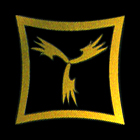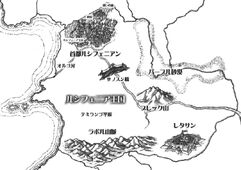
Lucifenia, formerly the Kingdom of Lucifenia or the Yellow Kingdom during its early history and later reorganized as the Lucifenian Republic, is a country directly south of Elphegort, associated with the Deadly Sin of Vanity.
History[]
Lucifenia was a territory within the Beelzenian Empire. The territory began campaigning for its independence in EC 399 and later won it. That same year, Lucifen I was crowned the new country's monarch and led the national construction for the "Kingdom of Lucifenia". In EC 480, the mage Elluka Clockworker signed the Sanosun Bridge Oath with King Arth I, becoming his subordinate, and Lucifenia began expanding its borders. The nation declared war against Asmodean and slowly gained territory from its neighbor. The Beelzenian Empire later declared war on Lucifenia as it regained power. Beelzenia was weakened over time and by EC 490 Lucifenia gained the Empire's southern territory of Evagrius.
Lucifenia owned a large portion of Beelzenia's territory. Sometime after EC 491, Arth Lucifen d'Autriche died of the Gula disease and was succeeded by his wife. Under the rule of Queen

Anne Lucifen d'Autriche, the Kingdom of Lucifenia prospered until her death in EC 499; she was succeeded by her daughter, Princess Riliane Lucifen d'Autriche. In the year EC 500, Lucifenia invaded Elphegort and instigated the genocide of the green-haired female populace, later called "The Green Hunting". The hunt ended when the intended target was killed and Elphegort was occupied although the fighting continued in what was called the "Green Hunting".
Lucifenia continued warring with remnants of the Elphegort military. Shortly after, violence broke out as the Lucifenian Revolution led by Germaine Avadonia quickly gained momentum and overtook the country. Riliane was overthrown, imprisoned, and later publically executed as a result of the revolution. After that, the country was incorporated as a Marlon principality. It would be given independence by King Kyle Marlon in EC 505. In EC 508, the country was reorganized as a republic.
The criminal organization Pere Noel's based themselves in Lucifenia around EC 609. Lucifenia was later incorporated into the Union State of Evillious in EC 878.
Locations[]
Lucifenian Royal Palace (Northern Lucifenia)[]
The abode of the Lucifen Royal Family.
Forest of Bewilderment (North of the Lucifenian Royal Palace)[]
A forest between Lucifenia and Elphegort, connecting to the Eldoh's Forest. Long ago, Lucifenia's army tried to use it as a route to invade Elphegort; the forest was known to be tricky and easy to get lost in, therefore the route was discarded since it represented a tactical disadvantage.
Princess Riliane ordered an assault on Elphegort using the forest as a direct path. Consequently, half of it was burnt down during the "Green Hunting".
Lucifenian[]
The capital city of Lucifenia.
Deserted House[]
The Lucifenian Resistance used this house as their headquarters.
Sanosun Bridge[]
The venue for the "Oath of the Sanosun Bridge", a contract held between King Arth and The Three Heroes. It connects Babul Desert with the Temilamb Plain.
Eldoh Monastery[]
A Levin Monastery located close to an "Anonymous Coast". Built by the Freesis Foundation, this monastery became Clarith and Riliane's home after the Lucifenian Revolution. The monastery had several orphans residing there.
Retasan Fortress (Southeastern Lucifenia)[]
A fortress that serves as an entrance and exit from Lucifenia to Beelzenia. It is lost to Beelzenia in EC 505.
Orgo River (Flows from East Lucifenia to Hawk Sea)[]
Babul Desert (Boundary between Lucifenia & Asmodean)[]
Breck Mountain (South of Babul Desert, Eastern Lucifenia)[]
Temilamb Plain (Central Lucifenia)[]
Lavolle Mountains (South Lucifenia)[]
Known residents[]
Trivia[]
Conceptualization and Origin[]
- Lucifenia is inspired by the real world nation of France. The Kingdom of Lucifenia's history bears many similarities and influences with that of the Kingdom of France.
- The relationship between Riliane Lucifen d'Autriche and the Lucifenian Revolution is very similar to the relationship between Marie Antoinette and the French Revolution.
- Its name is based on Lucifer, the patron demon of Pride.
Curiosities[]
- Desert Bluebird takes place in an alternate version of Lucifenia where the world was destroyed. Lucifenia's emblem also shows up in the form of feathers, later revealed to be masking a nuclear sign.
- The crest of Lucifenia also was featured on the Project Mirai, during the PVs for The Daughter of Evil and The Servant of Evil.
- The crest of Lucifenia appears to be three stylized wings. This may be a reference to Lucifer's status as a fallen angel. Three is also a divine number in some religions.
Gallery[]


























